Self-Management for Type 2 Diabetes in Elderly England Patients
VerifiedAdded on 2021/03/19
|46
|11939
|54
Thesis and Dissertation
AI Summary
This dissertation investigates self-management practices for elderly individuals with type 2 diabetes in England. The research begins with an introduction to diabetes, emphasizing the prevalence of type 2 diabetes among the elderly and the importance of self-management. It highlights the research rationale, limitations, aims, and objectives. Chapter 2 presents a comprehensive literature review on diabetes self-management education (DSME), its effectiveness, and the specific challenges faced by older adults. The methodology chapter outlines the research purpose, philosophy, approach, design, data sources, sampling, ethical considerations, and the questionnaire used. Chapter 4 presents the data and findings, while Chapter 5 concludes with recommendations for further research and development. The study emphasizes the need for individualized DSME, the involvement of multiple disciplines, and the role of healthcare teams in supporting self-management. The research aims to address gaps in existing literature by examining self-management strategies and their impact on elderly patients with type 2 diabetes in England, focusing on the complexities of their health conditions and the need for tailored care.
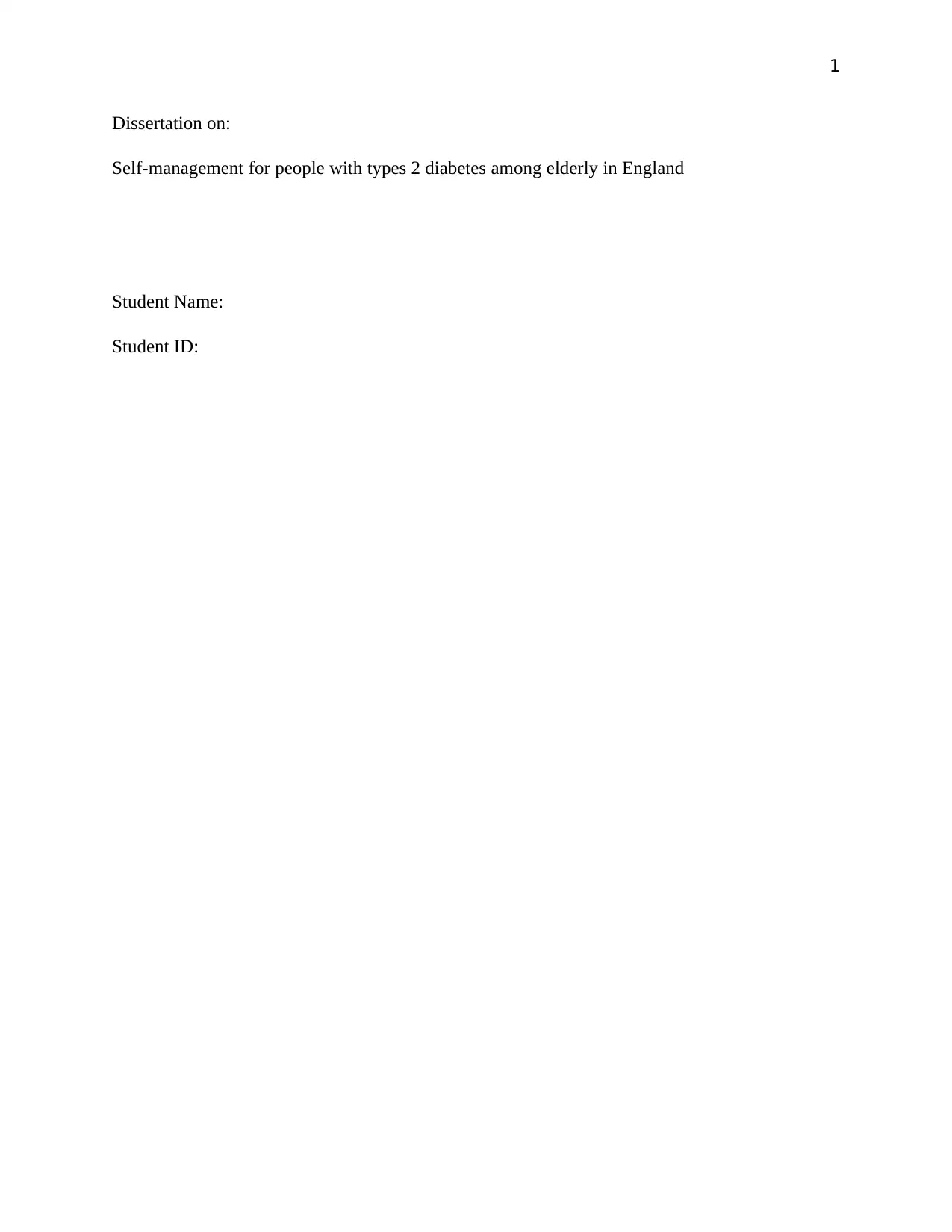
1
Dissertation on:
Self-management for people with types 2 diabetes among elderly in England
Student Name:
Student ID:
Dissertation on:
Self-management for people with types 2 diabetes among elderly in England
Student Name:
Student ID:
Paraphrase This Document
Need a fresh take? Get an instant paraphrase of this document with our AI Paraphraser
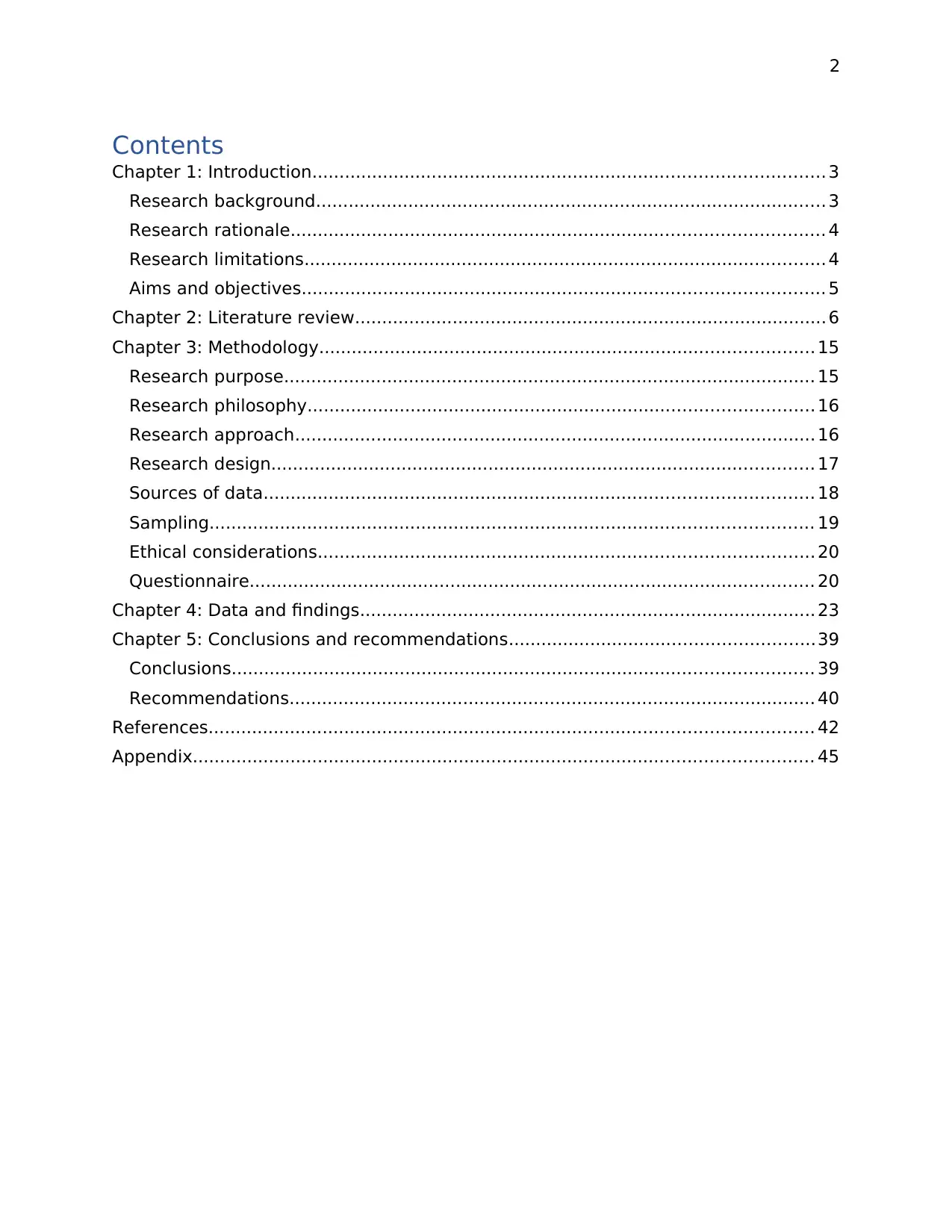
2
Contents
Chapter 1: Introduction.............................................................................................. 3
Research background.............................................................................................. 3
Research rationale.................................................................................................. 4
Research limitations................................................................................................ 4
Aims and objectives................................................................................................ 5
Chapter 2: Literature review....................................................................................... 6
Chapter 3: Methodology........................................................................................... 15
Research purpose.................................................................................................. 15
Research philosophy............................................................................................. 16
Research approach................................................................................................ 16
Research design.................................................................................................... 17
Sources of data..................................................................................................... 18
Sampling............................................................................................................... 19
Ethical considerations........................................................................................... 20
Questionnaire........................................................................................................ 20
Chapter 4: Data and findings.................................................................................... 23
Chapter 5: Conclusions and recommendations........................................................39
Conclusions........................................................................................................... 39
Recommendations................................................................................................. 40
References............................................................................................................... 42
Appendix.................................................................................................................. 45
Contents
Chapter 1: Introduction.............................................................................................. 3
Research background.............................................................................................. 3
Research rationale.................................................................................................. 4
Research limitations................................................................................................ 4
Aims and objectives................................................................................................ 5
Chapter 2: Literature review....................................................................................... 6
Chapter 3: Methodology........................................................................................... 15
Research purpose.................................................................................................. 15
Research philosophy............................................................................................. 16
Research approach................................................................................................ 16
Research design.................................................................................................... 17
Sources of data..................................................................................................... 18
Sampling............................................................................................................... 19
Ethical considerations........................................................................................... 20
Questionnaire........................................................................................................ 20
Chapter 4: Data and findings.................................................................................... 23
Chapter 5: Conclusions and recommendations........................................................39
Conclusions........................................................................................................... 39
Recommendations................................................................................................. 40
References............................................................................................................... 42
Appendix.................................................................................................................. 45
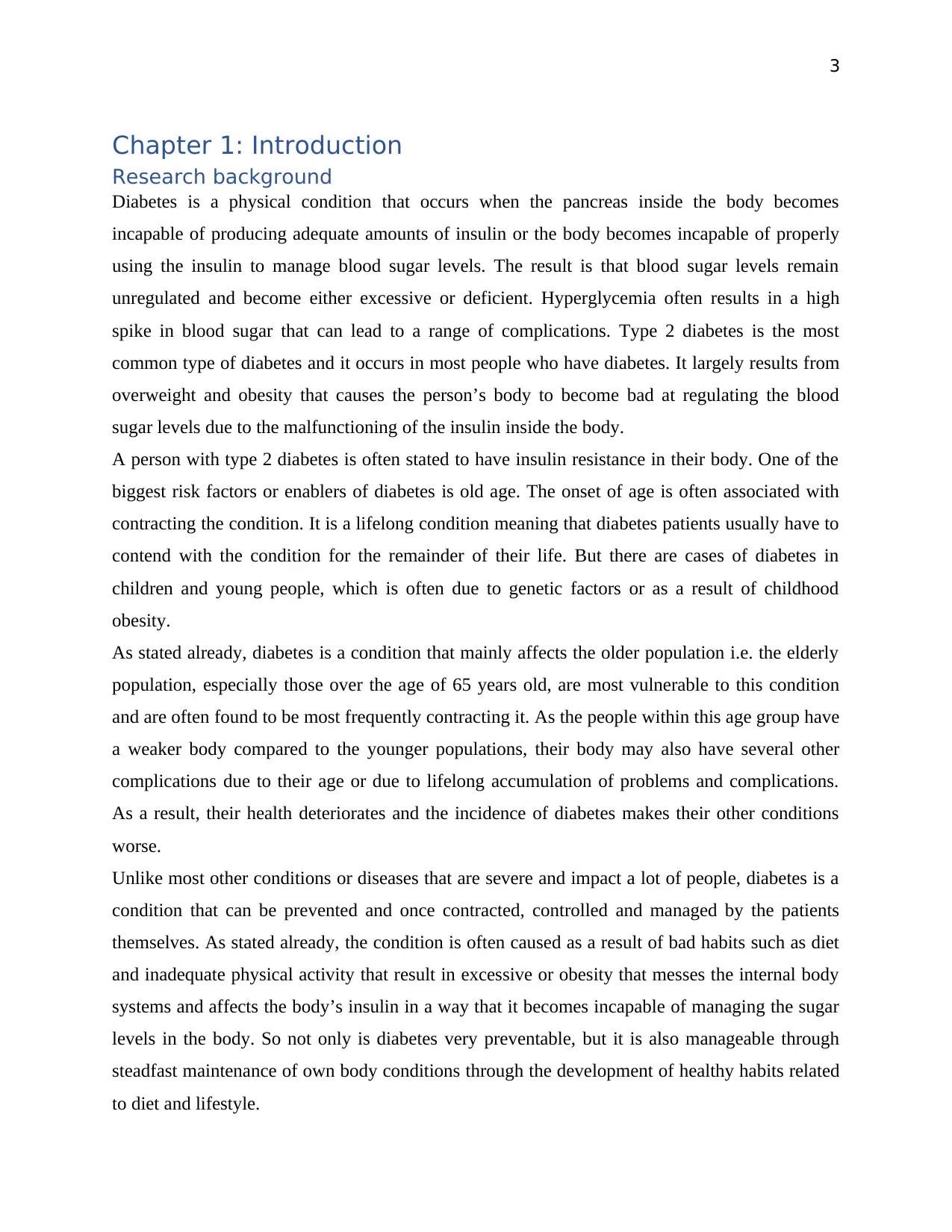
3
Chapter 1: Introduction
Research background
Diabetes is a physical condition that occurs when the pancreas inside the body becomes
incapable of producing adequate amounts of insulin or the body becomes incapable of properly
using the insulin to manage blood sugar levels. The result is that blood sugar levels remain
unregulated and become either excessive or deficient. Hyperglycemia often results in a high
spike in blood sugar that can lead to a range of complications. Type 2 diabetes is the most
common type of diabetes and it occurs in most people who have diabetes. It largely results from
overweight and obesity that causes the person’s body to become bad at regulating the blood
sugar levels due to the malfunctioning of the insulin inside the body.
A person with type 2 diabetes is often stated to have insulin resistance in their body. One of the
biggest risk factors or enablers of diabetes is old age. The onset of age is often associated with
contracting the condition. It is a lifelong condition meaning that diabetes patients usually have to
contend with the condition for the remainder of their life. But there are cases of diabetes in
children and young people, which is often due to genetic factors or as a result of childhood
obesity.
As stated already, diabetes is a condition that mainly affects the older population i.e. the elderly
population, especially those over the age of 65 years old, are most vulnerable to this condition
and are often found to be most frequently contracting it. As the people within this age group have
a weaker body compared to the younger populations, their body may also have several other
complications due to their age or due to lifelong accumulation of problems and complications.
As a result, their health deteriorates and the incidence of diabetes makes their other conditions
worse.
Unlike most other conditions or diseases that are severe and impact a lot of people, diabetes is a
condition that can be prevented and once contracted, controlled and managed by the patients
themselves. As stated already, the condition is often caused as a result of bad habits such as diet
and inadequate physical activity that result in excessive or obesity that messes the internal body
systems and affects the body’s insulin in a way that it becomes incapable of managing the sugar
levels in the body. So not only is diabetes very preventable, but it is also manageable through
steadfast maintenance of own body conditions through the development of healthy habits related
to diet and lifestyle.
Chapter 1: Introduction
Research background
Diabetes is a physical condition that occurs when the pancreas inside the body becomes
incapable of producing adequate amounts of insulin or the body becomes incapable of properly
using the insulin to manage blood sugar levels. The result is that blood sugar levels remain
unregulated and become either excessive or deficient. Hyperglycemia often results in a high
spike in blood sugar that can lead to a range of complications. Type 2 diabetes is the most
common type of diabetes and it occurs in most people who have diabetes. It largely results from
overweight and obesity that causes the person’s body to become bad at regulating the blood
sugar levels due to the malfunctioning of the insulin inside the body.
A person with type 2 diabetes is often stated to have insulin resistance in their body. One of the
biggest risk factors or enablers of diabetes is old age. The onset of age is often associated with
contracting the condition. It is a lifelong condition meaning that diabetes patients usually have to
contend with the condition for the remainder of their life. But there are cases of diabetes in
children and young people, which is often due to genetic factors or as a result of childhood
obesity.
As stated already, diabetes is a condition that mainly affects the older population i.e. the elderly
population, especially those over the age of 65 years old, are most vulnerable to this condition
and are often found to be most frequently contracting it. As the people within this age group have
a weaker body compared to the younger populations, their body may also have several other
complications due to their age or due to lifelong accumulation of problems and complications.
As a result, their health deteriorates and the incidence of diabetes makes their other conditions
worse.
Unlike most other conditions or diseases that are severe and impact a lot of people, diabetes is a
condition that can be prevented and once contracted, controlled and managed by the patients
themselves. As stated already, the condition is often caused as a result of bad habits such as diet
and inadequate physical activity that result in excessive or obesity that messes the internal body
systems and affects the body’s insulin in a way that it becomes incapable of managing the sugar
levels in the body. So not only is diabetes very preventable, but it is also manageable through
steadfast maintenance of own body conditions through the development of healthy habits related
to diet and lifestyle.
⊘ This is a preview!⊘
Do you want full access?
Subscribe today to unlock all pages.

Trusted by 1+ million students worldwide
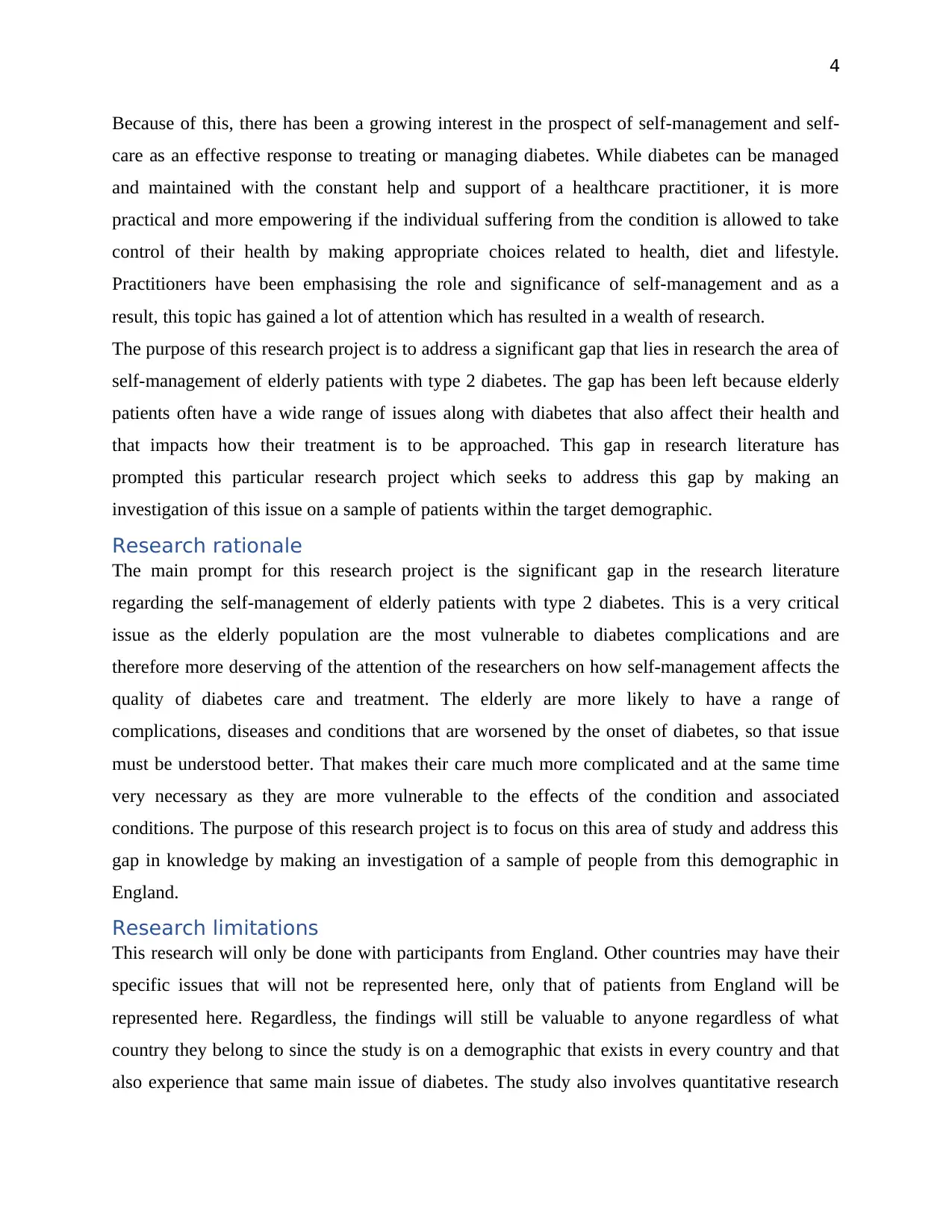
4
Because of this, there has been a growing interest in the prospect of self-management and self-
care as an effective response to treating or managing diabetes. While diabetes can be managed
and maintained with the constant help and support of a healthcare practitioner, it is more
practical and more empowering if the individual suffering from the condition is allowed to take
control of their health by making appropriate choices related to health, diet and lifestyle.
Practitioners have been emphasising the role and significance of self-management and as a
result, this topic has gained a lot of attention which has resulted in a wealth of research.
The purpose of this research project is to address a significant gap that lies in research the area of
self-management of elderly patients with type 2 diabetes. The gap has been left because elderly
patients often have a wide range of issues along with diabetes that also affect their health and
that impacts how their treatment is to be approached. This gap in research literature has
prompted this particular research project which seeks to address this gap by making an
investigation of this issue on a sample of patients within the target demographic.
Research rationale
The main prompt for this research project is the significant gap in the research literature
regarding the self-management of elderly patients with type 2 diabetes. This is a very critical
issue as the elderly population are the most vulnerable to diabetes complications and are
therefore more deserving of the attention of the researchers on how self-management affects the
quality of diabetes care and treatment. The elderly are more likely to have a range of
complications, diseases and conditions that are worsened by the onset of diabetes, so that issue
must be understood better. That makes their care much more complicated and at the same time
very necessary as they are more vulnerable to the effects of the condition and associated
conditions. The purpose of this research project is to focus on this area of study and address this
gap in knowledge by making an investigation of a sample of people from this demographic in
England.
Research limitations
This research will only be done with participants from England. Other countries may have their
specific issues that will not be represented here, only that of patients from England will be
represented here. Regardless, the findings will still be valuable to anyone regardless of what
country they belong to since the study is on a demographic that exists in every country and that
also experience that same main issue of diabetes. The study also involves quantitative research
Because of this, there has been a growing interest in the prospect of self-management and self-
care as an effective response to treating or managing diabetes. While diabetes can be managed
and maintained with the constant help and support of a healthcare practitioner, it is more
practical and more empowering if the individual suffering from the condition is allowed to take
control of their health by making appropriate choices related to health, diet and lifestyle.
Practitioners have been emphasising the role and significance of self-management and as a
result, this topic has gained a lot of attention which has resulted in a wealth of research.
The purpose of this research project is to address a significant gap that lies in research the area of
self-management of elderly patients with type 2 diabetes. The gap has been left because elderly
patients often have a wide range of issues along with diabetes that also affect their health and
that impacts how their treatment is to be approached. This gap in research literature has
prompted this particular research project which seeks to address this gap by making an
investigation of this issue on a sample of patients within the target demographic.
Research rationale
The main prompt for this research project is the significant gap in the research literature
regarding the self-management of elderly patients with type 2 diabetes. This is a very critical
issue as the elderly population are the most vulnerable to diabetes complications and are
therefore more deserving of the attention of the researchers on how self-management affects the
quality of diabetes care and treatment. The elderly are more likely to have a range of
complications, diseases and conditions that are worsened by the onset of diabetes, so that issue
must be understood better. That makes their care much more complicated and at the same time
very necessary as they are more vulnerable to the effects of the condition and associated
conditions. The purpose of this research project is to focus on this area of study and address this
gap in knowledge by making an investigation of a sample of people from this demographic in
England.
Research limitations
This research will only be done with participants from England. Other countries may have their
specific issues that will not be represented here, only that of patients from England will be
represented here. Regardless, the findings will still be valuable to anyone regardless of what
country they belong to since the study is on a demographic that exists in every country and that
also experience that same main issue of diabetes. The study also involves quantitative research
Paraphrase This Document
Need a fresh take? Get an instant paraphrase of this document with our AI Paraphraser
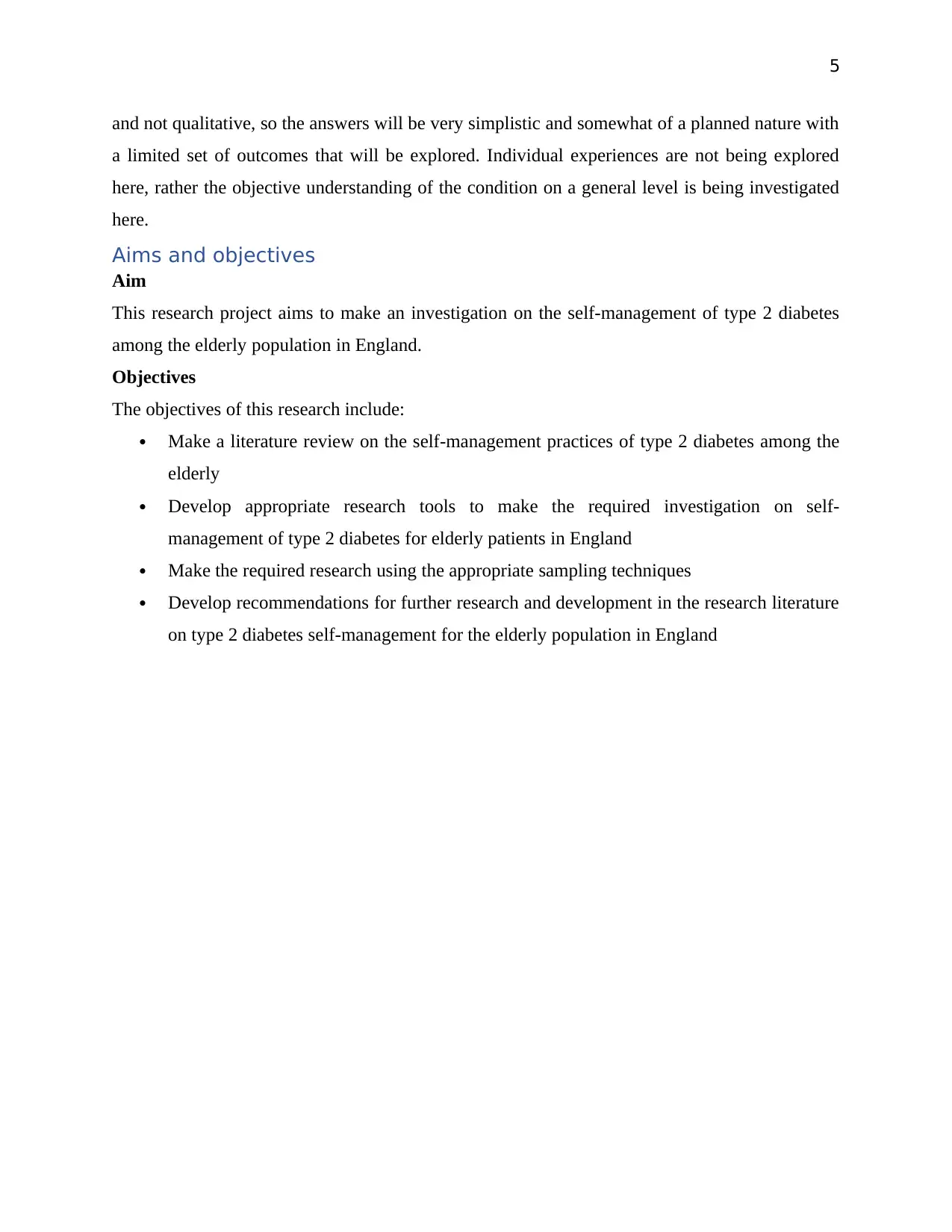
5
and not qualitative, so the answers will be very simplistic and somewhat of a planned nature with
a limited set of outcomes that will be explored. Individual experiences are not being explored
here, rather the objective understanding of the condition on a general level is being investigated
here.
Aims and objectives
Aim
This research project aims to make an investigation on the self-management of type 2 diabetes
among the elderly population in England.
Objectives
The objectives of this research include:
Make a literature review on the self-management practices of type 2 diabetes among the
elderly
Develop appropriate research tools to make the required investigation on self-
management of type 2 diabetes for elderly patients in England
Make the required research using the appropriate sampling techniques
Develop recommendations for further research and development in the research literature
on type 2 diabetes self-management for the elderly population in England
and not qualitative, so the answers will be very simplistic and somewhat of a planned nature with
a limited set of outcomes that will be explored. Individual experiences are not being explored
here, rather the objective understanding of the condition on a general level is being investigated
here.
Aims and objectives
Aim
This research project aims to make an investigation on the self-management of type 2 diabetes
among the elderly population in England.
Objectives
The objectives of this research include:
Make a literature review on the self-management practices of type 2 diabetes among the
elderly
Develop appropriate research tools to make the required investigation on self-
management of type 2 diabetes for elderly patients in England
Make the required research using the appropriate sampling techniques
Develop recommendations for further research and development in the research literature
on type 2 diabetes self-management for the elderly population in England
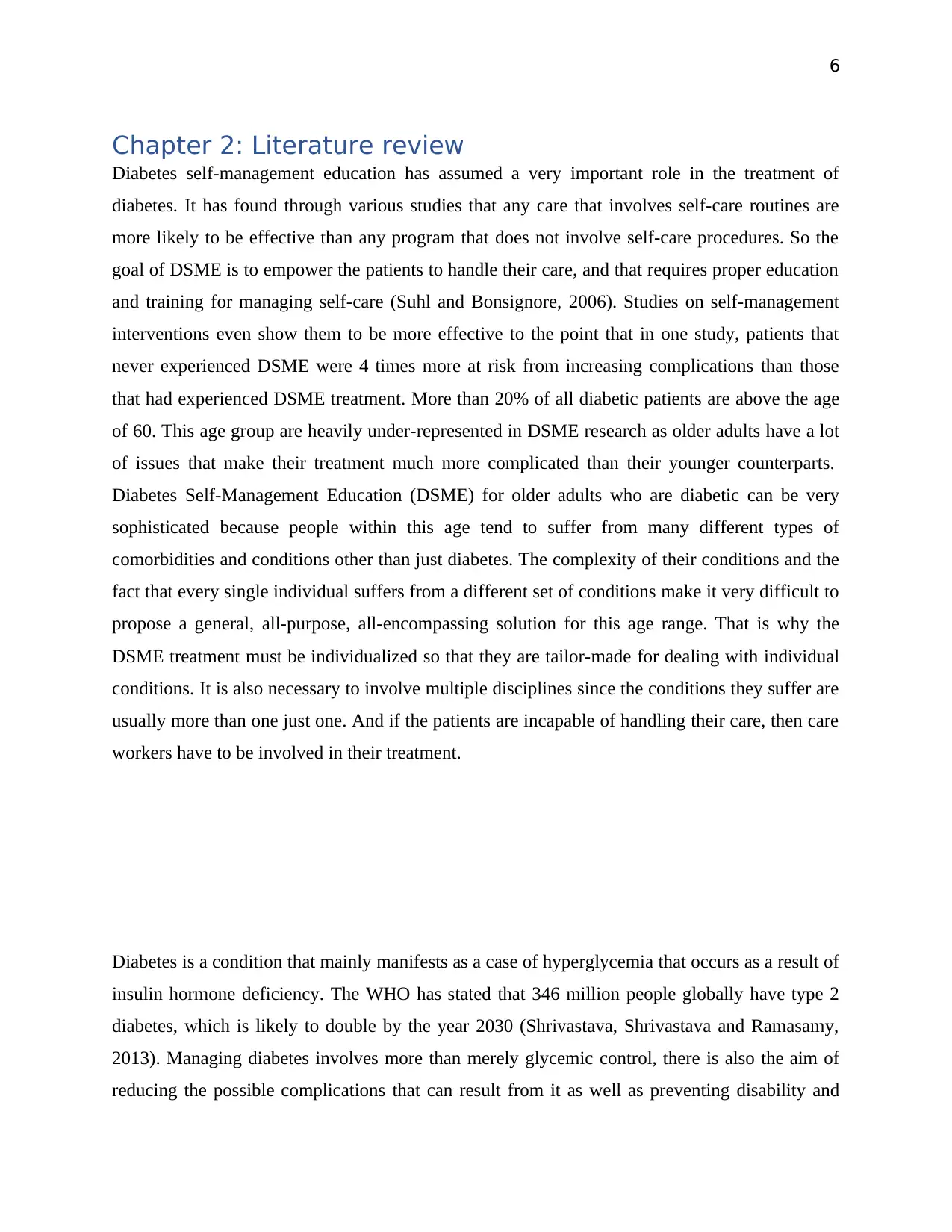
6
Chapter 2: Literature review
Diabetes self-management education has assumed a very important role in the treatment of
diabetes. It has found through various studies that any care that involves self-care routines are
more likely to be effective than any program that does not involve self-care procedures. So the
goal of DSME is to empower the patients to handle their care, and that requires proper education
and training for managing self-care (Suhl and Bonsignore, 2006). Studies on self-management
interventions even show them to be more effective to the point that in one study, patients that
never experienced DSME were 4 times more at risk from increasing complications than those
that had experienced DSME treatment. More than 20% of all diabetic patients are above the age
of 60. This age group are heavily under-represented in DSME research as older adults have a lot
of issues that make their treatment much more complicated than their younger counterparts.
Diabetes Self-Management Education (DSME) for older adults who are diabetic can be very
sophisticated because people within this age tend to suffer from many different types of
comorbidities and conditions other than just diabetes. The complexity of their conditions and the
fact that every single individual suffers from a different set of conditions make it very difficult to
propose a general, all-purpose, all-encompassing solution for this age range. That is why the
DSME treatment must be individualized so that they are tailor-made for dealing with individual
conditions. It is also necessary to involve multiple disciplines since the conditions they suffer are
usually more than one just one. And if the patients are incapable of handling their care, then care
workers have to be involved in their treatment.
Diabetes is a condition that mainly manifests as a case of hyperglycemia that occurs as a result of
insulin hormone deficiency. The WHO has stated that 346 million people globally have type 2
diabetes, which is likely to double by the year 2030 (Shrivastava, Shrivastava and Ramasamy,
2013). Managing diabetes involves more than merely glycemic control, there is also the aim of
reducing the possible complications that can result from it as well as preventing disability and
Chapter 2: Literature review
Diabetes self-management education has assumed a very important role in the treatment of
diabetes. It has found through various studies that any care that involves self-care routines are
more likely to be effective than any program that does not involve self-care procedures. So the
goal of DSME is to empower the patients to handle their care, and that requires proper education
and training for managing self-care (Suhl and Bonsignore, 2006). Studies on self-management
interventions even show them to be more effective to the point that in one study, patients that
never experienced DSME were 4 times more at risk from increasing complications than those
that had experienced DSME treatment. More than 20% of all diabetic patients are above the age
of 60. This age group are heavily under-represented in DSME research as older adults have a lot
of issues that make their treatment much more complicated than their younger counterparts.
Diabetes Self-Management Education (DSME) for older adults who are diabetic can be very
sophisticated because people within this age tend to suffer from many different types of
comorbidities and conditions other than just diabetes. The complexity of their conditions and the
fact that every single individual suffers from a different set of conditions make it very difficult to
propose a general, all-purpose, all-encompassing solution for this age range. That is why the
DSME treatment must be individualized so that they are tailor-made for dealing with individual
conditions. It is also necessary to involve multiple disciplines since the conditions they suffer are
usually more than one just one. And if the patients are incapable of handling their care, then care
workers have to be involved in their treatment.
Diabetes is a condition that mainly manifests as a case of hyperglycemia that occurs as a result of
insulin hormone deficiency. The WHO has stated that 346 million people globally have type 2
diabetes, which is likely to double by the year 2030 (Shrivastava, Shrivastava and Ramasamy,
2013). Managing diabetes involves more than merely glycemic control, there is also the aim of
reducing the possible complications that can result from it as well as preventing disability and
⊘ This is a preview!⊘
Do you want full access?
Subscribe today to unlock all pages.

Trusted by 1+ million students worldwide
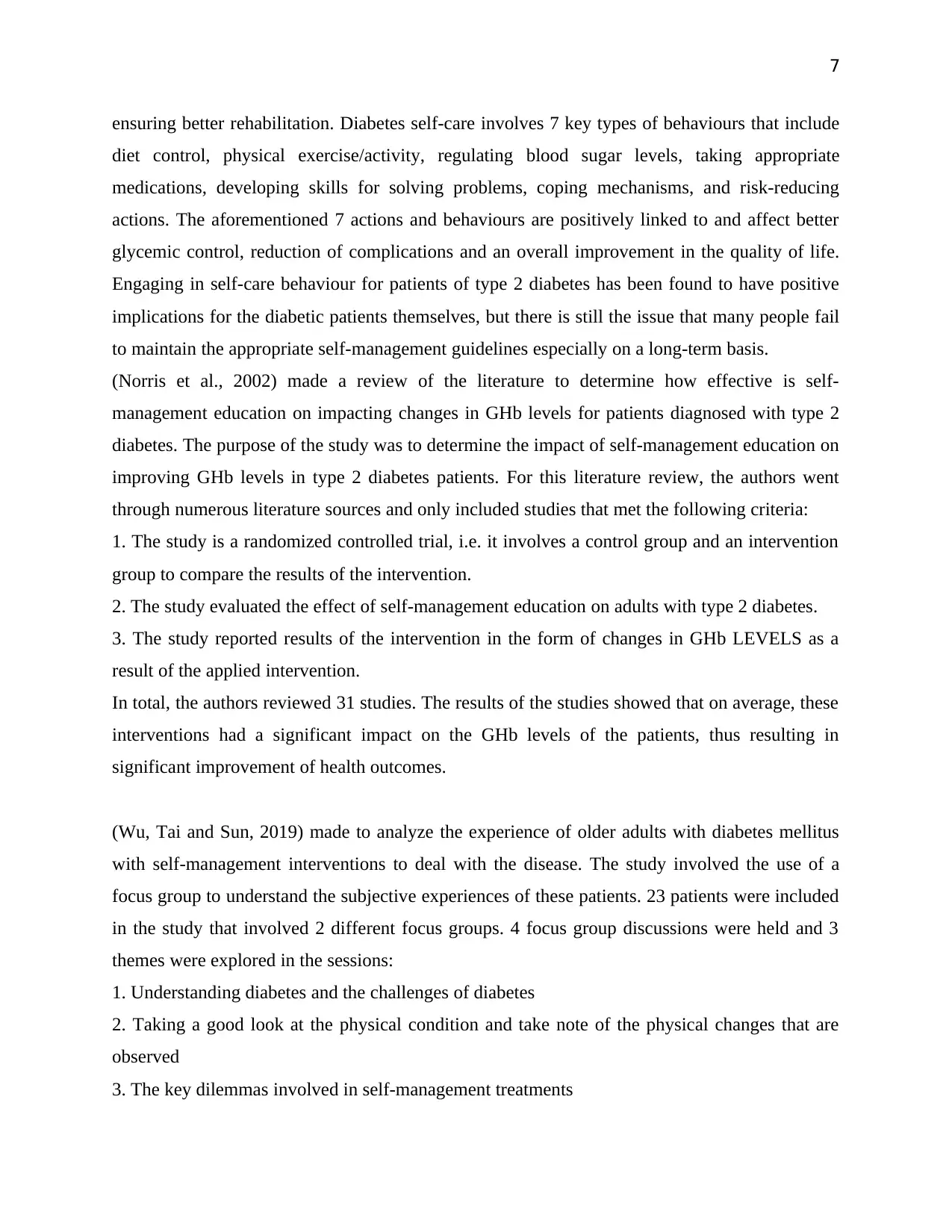
7
ensuring better rehabilitation. Diabetes self-care involves 7 key types of behaviours that include
diet control, physical exercise/activity, regulating blood sugar levels, taking appropriate
medications, developing skills for solving problems, coping mechanisms, and risk-reducing
actions. The aforementioned 7 actions and behaviours are positively linked to and affect better
glycemic control, reduction of complications and an overall improvement in the quality of life.
Engaging in self-care behaviour for patients of type 2 diabetes has been found to have positive
implications for the diabetic patients themselves, but there is still the issue that many people fail
to maintain the appropriate self-management guidelines especially on a long-term basis.
(Norris et al., 2002) made a review of the literature to determine how effective is self-
management education on impacting changes in GHb levels for patients diagnosed with type 2
diabetes. The purpose of the study was to determine the impact of self-management education on
improving GHb levels in type 2 diabetes patients. For this literature review, the authors went
through numerous literature sources and only included studies that met the following criteria:
1. The study is a randomized controlled trial, i.e. it involves a control group and an intervention
group to compare the results of the intervention.
2. The study evaluated the effect of self-management education on adults with type 2 diabetes.
3. The study reported results of the intervention in the form of changes in GHb LEVELS as a
result of the applied intervention.
In total, the authors reviewed 31 studies. The results of the studies showed that on average, these
interventions had a significant impact on the GHb levels of the patients, thus resulting in
significant improvement of health outcomes.
(Wu, Tai and Sun, 2019) made to analyze the experience of older adults with diabetes mellitus
with self-management interventions to deal with the disease. The study involved the use of a
focus group to understand the subjective experiences of these patients. 23 patients were included
in the study that involved 2 different focus groups. 4 focus group discussions were held and 3
themes were explored in the sessions:
1. Understanding diabetes and the challenges of diabetes
2. Taking a good look at the physical condition and take note of the physical changes that are
observed
3. The key dilemmas involved in self-management treatments
ensuring better rehabilitation. Diabetes self-care involves 7 key types of behaviours that include
diet control, physical exercise/activity, regulating blood sugar levels, taking appropriate
medications, developing skills for solving problems, coping mechanisms, and risk-reducing
actions. The aforementioned 7 actions and behaviours are positively linked to and affect better
glycemic control, reduction of complications and an overall improvement in the quality of life.
Engaging in self-care behaviour for patients of type 2 diabetes has been found to have positive
implications for the diabetic patients themselves, but there is still the issue that many people fail
to maintain the appropriate self-management guidelines especially on a long-term basis.
(Norris et al., 2002) made a review of the literature to determine how effective is self-
management education on impacting changes in GHb levels for patients diagnosed with type 2
diabetes. The purpose of the study was to determine the impact of self-management education on
improving GHb levels in type 2 diabetes patients. For this literature review, the authors went
through numerous literature sources and only included studies that met the following criteria:
1. The study is a randomized controlled trial, i.e. it involves a control group and an intervention
group to compare the results of the intervention.
2. The study evaluated the effect of self-management education on adults with type 2 diabetes.
3. The study reported results of the intervention in the form of changes in GHb LEVELS as a
result of the applied intervention.
In total, the authors reviewed 31 studies. The results of the studies showed that on average, these
interventions had a significant impact on the GHb levels of the patients, thus resulting in
significant improvement of health outcomes.
(Wu, Tai and Sun, 2019) made to analyze the experience of older adults with diabetes mellitus
with self-management interventions to deal with the disease. The study involved the use of a
focus group to understand the subjective experiences of these patients. 23 patients were included
in the study that involved 2 different focus groups. 4 focus group discussions were held and 3
themes were explored in the sessions:
1. Understanding diabetes and the challenges of diabetes
2. Taking a good look at the physical condition and take note of the physical changes that are
observed
3. The key dilemmas involved in self-management treatments
Paraphrase This Document
Need a fresh take? Get an instant paraphrase of this document with our AI Paraphraser
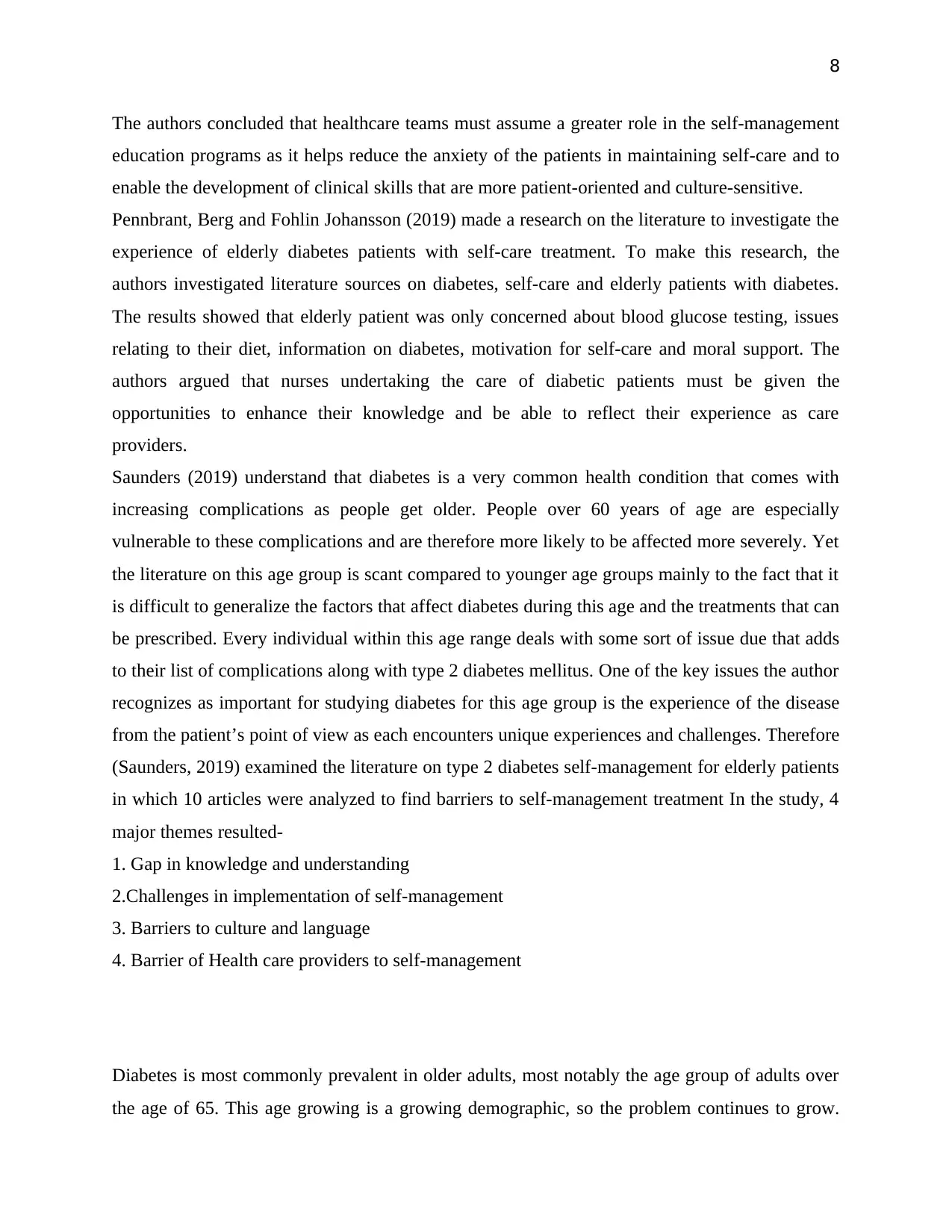
8
The authors concluded that healthcare teams must assume a greater role in the self-management
education programs as it helps reduce the anxiety of the patients in maintaining self-care and to
enable the development of clinical skills that are more patient-oriented and culture-sensitive.
Pennbrant, Berg and Fohlin Johansson (2019) made a research on the literature to investigate the
experience of elderly diabetes patients with self-care treatment. To make this research, the
authors investigated literature sources on diabetes, self-care and elderly patients with diabetes.
The results showed that elderly patient was only concerned about blood glucose testing, issues
relating to their diet, information on diabetes, motivation for self-care and moral support. The
authors argued that nurses undertaking the care of diabetic patients must be given the
opportunities to enhance their knowledge and be able to reflect their experience as care
providers.
Saunders (2019) understand that diabetes is a very common health condition that comes with
increasing complications as people get older. People over 60 years of age are especially
vulnerable to these complications and are therefore more likely to be affected more severely. Yet
the literature on this age group is scant compared to younger age groups mainly to the fact that it
is difficult to generalize the factors that affect diabetes during this age and the treatments that can
be prescribed. Every individual within this age range deals with some sort of issue due that adds
to their list of complications along with type 2 diabetes mellitus. One of the key issues the author
recognizes as important for studying diabetes for this age group is the experience of the disease
from the patient’s point of view as each encounters unique experiences and challenges. Therefore
(Saunders, 2019) examined the literature on type 2 diabetes self-management for elderly patients
in which 10 articles were analyzed to find barriers to self-management treatment In the study, 4
major themes resulted-
1. Gap in knowledge and understanding
2.Challenges in implementation of self-management
3. Barriers to culture and language
4. Barrier of Health care providers to self-management
Diabetes is most commonly prevalent in older adults, most notably the age group of adults over
the age of 65. This age growing is a growing demographic, so the problem continues to grow.
The authors concluded that healthcare teams must assume a greater role in the self-management
education programs as it helps reduce the anxiety of the patients in maintaining self-care and to
enable the development of clinical skills that are more patient-oriented and culture-sensitive.
Pennbrant, Berg and Fohlin Johansson (2019) made a research on the literature to investigate the
experience of elderly diabetes patients with self-care treatment. To make this research, the
authors investigated literature sources on diabetes, self-care and elderly patients with diabetes.
The results showed that elderly patient was only concerned about blood glucose testing, issues
relating to their diet, information on diabetes, motivation for self-care and moral support. The
authors argued that nurses undertaking the care of diabetic patients must be given the
opportunities to enhance their knowledge and be able to reflect their experience as care
providers.
Saunders (2019) understand that diabetes is a very common health condition that comes with
increasing complications as people get older. People over 60 years of age are especially
vulnerable to these complications and are therefore more likely to be affected more severely. Yet
the literature on this age group is scant compared to younger age groups mainly to the fact that it
is difficult to generalize the factors that affect diabetes during this age and the treatments that can
be prescribed. Every individual within this age range deals with some sort of issue due that adds
to their list of complications along with type 2 diabetes mellitus. One of the key issues the author
recognizes as important for studying diabetes for this age group is the experience of the disease
from the patient’s point of view as each encounters unique experiences and challenges. Therefore
(Saunders, 2019) examined the literature on type 2 diabetes self-management for elderly patients
in which 10 articles were analyzed to find barriers to self-management treatment In the study, 4
major themes resulted-
1. Gap in knowledge and understanding
2.Challenges in implementation of self-management
3. Barriers to culture and language
4. Barrier of Health care providers to self-management
Diabetes is most commonly prevalent in older adults, most notably the age group of adults over
the age of 65. This age growing is a growing demographic, so the problem continues to grow.
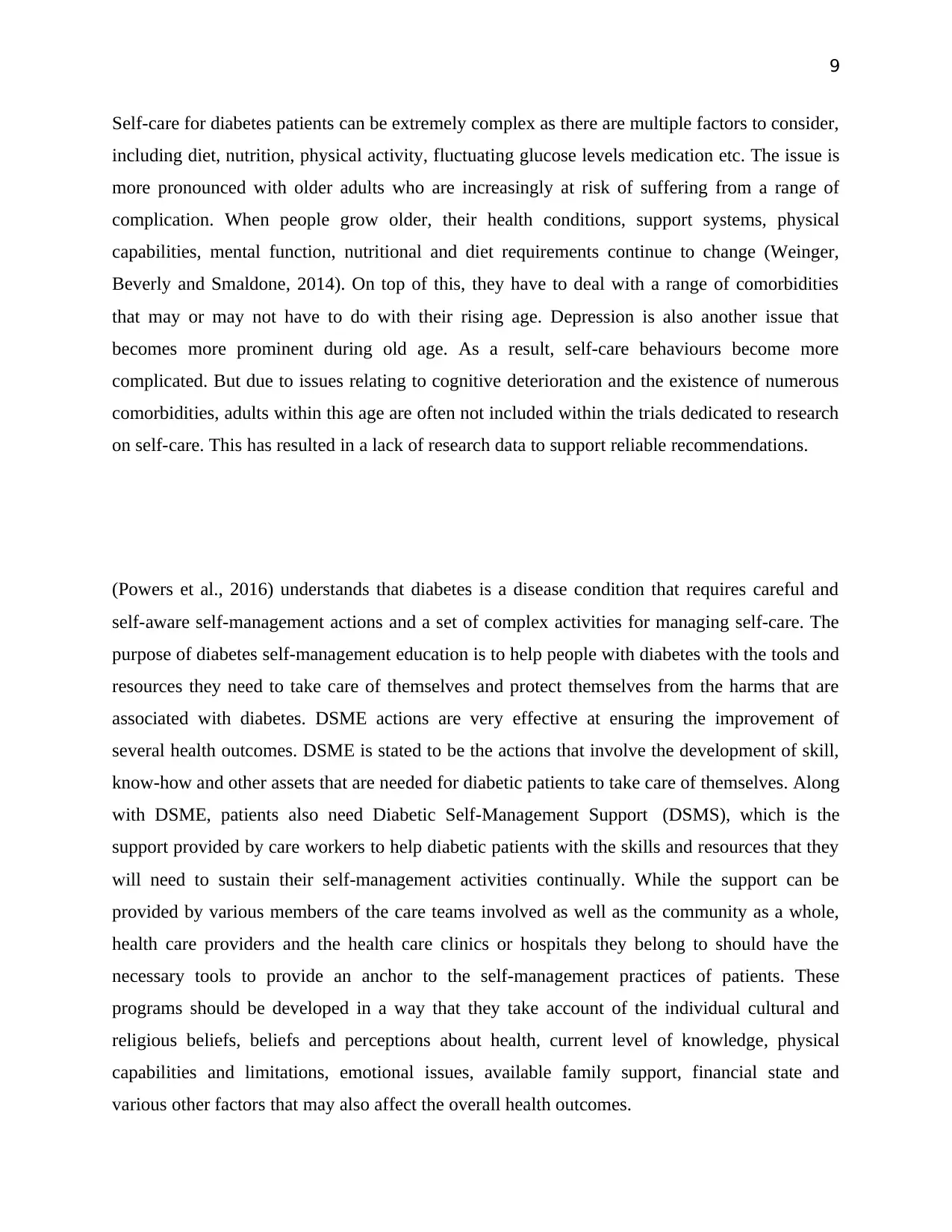
9
Self-care for diabetes patients can be extremely complex as there are multiple factors to consider,
including diet, nutrition, physical activity, fluctuating glucose levels medication etc. The issue is
more pronounced with older adults who are increasingly at risk of suffering from a range of
complication. When people grow older, their health conditions, support systems, physical
capabilities, mental function, nutritional and diet requirements continue to change (Weinger,
Beverly and Smaldone, 2014). On top of this, they have to deal with a range of comorbidities
that may or may not have to do with their rising age. Depression is also another issue that
becomes more prominent during old age. As a result, self-care behaviours become more
complicated. But due to issues relating to cognitive deterioration and the existence of numerous
comorbidities, adults within this age are often not included within the trials dedicated to research
on self-care. This has resulted in a lack of research data to support reliable recommendations.
(Powers et al., 2016) understands that diabetes is a disease condition that requires careful and
self-aware self-management actions and a set of complex activities for managing self-care. The
purpose of diabetes self-management education is to help people with diabetes with the tools and
resources they need to take care of themselves and protect themselves from the harms that are
associated with diabetes. DSME actions are very effective at ensuring the improvement of
several health outcomes. DSME is stated to be the actions that involve the development of skill,
know-how and other assets that are needed for diabetic patients to take care of themselves. Along
with DSME, patients also need Diabetic Self-Management Support (DSMS), which is the
support provided by care workers to help diabetic patients with the skills and resources that they
will need to sustain their self-management activities continually. While the support can be
provided by various members of the care teams involved as well as the community as a whole,
health care providers and the health care clinics or hospitals they belong to should have the
necessary tools to provide an anchor to the self-management practices of patients. These
programs should be developed in a way that they take account of the individual cultural and
religious beliefs, beliefs and perceptions about health, current level of knowledge, physical
capabilities and limitations, emotional issues, available family support, financial state and
various other factors that may also affect the overall health outcomes.
Self-care for diabetes patients can be extremely complex as there are multiple factors to consider,
including diet, nutrition, physical activity, fluctuating glucose levels medication etc. The issue is
more pronounced with older adults who are increasingly at risk of suffering from a range of
complication. When people grow older, their health conditions, support systems, physical
capabilities, mental function, nutritional and diet requirements continue to change (Weinger,
Beverly and Smaldone, 2014). On top of this, they have to deal with a range of comorbidities
that may or may not have to do with their rising age. Depression is also another issue that
becomes more prominent during old age. As a result, self-care behaviours become more
complicated. But due to issues relating to cognitive deterioration and the existence of numerous
comorbidities, adults within this age are often not included within the trials dedicated to research
on self-care. This has resulted in a lack of research data to support reliable recommendations.
(Powers et al., 2016) understands that diabetes is a disease condition that requires careful and
self-aware self-management actions and a set of complex activities for managing self-care. The
purpose of diabetes self-management education is to help people with diabetes with the tools and
resources they need to take care of themselves and protect themselves from the harms that are
associated with diabetes. DSME actions are very effective at ensuring the improvement of
several health outcomes. DSME is stated to be the actions that involve the development of skill,
know-how and other assets that are needed for diabetic patients to take care of themselves. Along
with DSME, patients also need Diabetic Self-Management Support (DSMS), which is the
support provided by care workers to help diabetic patients with the skills and resources that they
will need to sustain their self-management activities continually. While the support can be
provided by various members of the care teams involved as well as the community as a whole,
health care providers and the health care clinics or hospitals they belong to should have the
necessary tools to provide an anchor to the self-management practices of patients. These
programs should be developed in a way that they take account of the individual cultural and
religious beliefs, beliefs and perceptions about health, current level of knowledge, physical
capabilities and limitations, emotional issues, available family support, financial state and
various other factors that may also affect the overall health outcomes.
⊘ This is a preview!⊘
Do you want full access?
Subscribe today to unlock all pages.

Trusted by 1+ million students worldwide
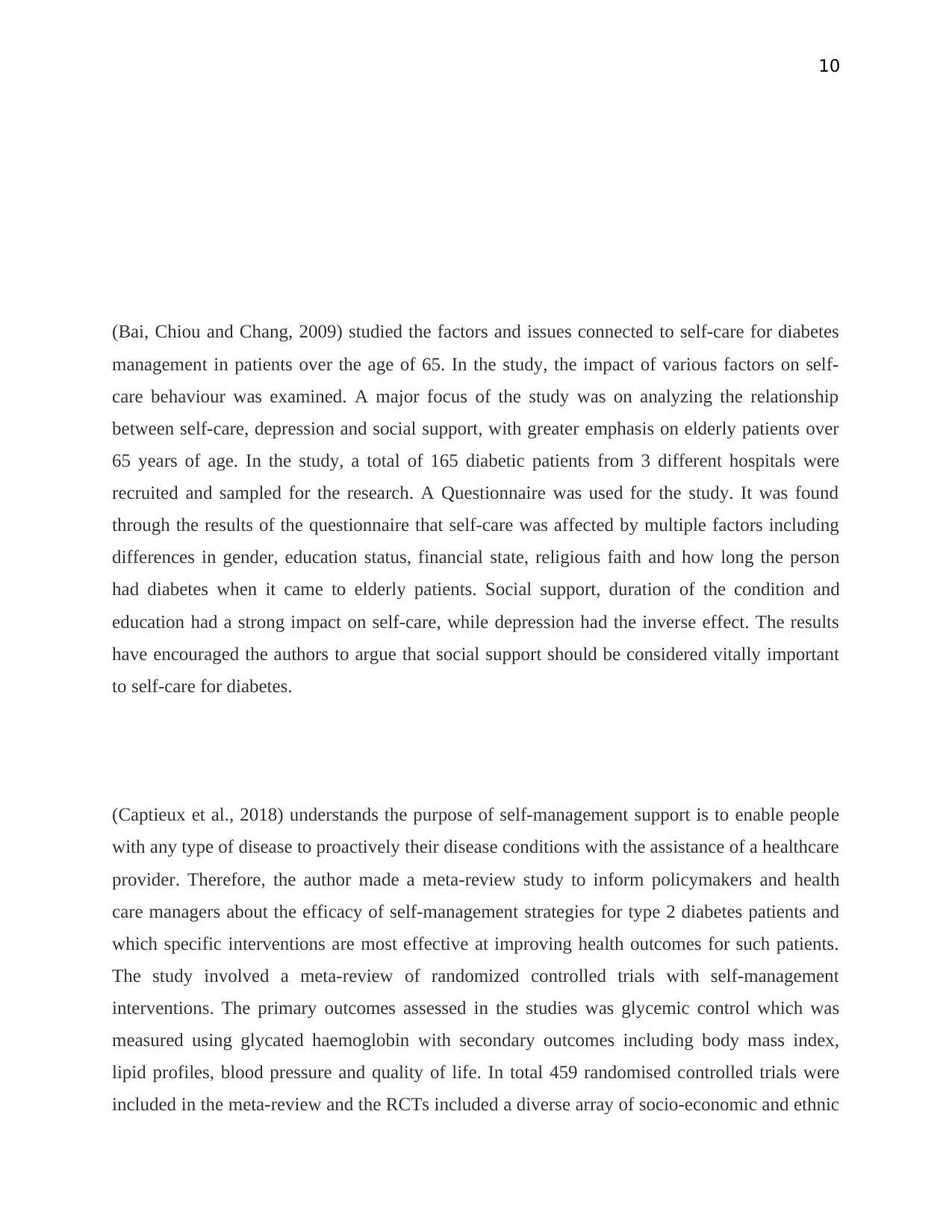
10
(Bai, Chiou and Chang, 2009) studied the factors and issues connected to self-care for diabetes
management in patients over the age of 65. In the study, the impact of various factors on self-
care behaviour was examined. A major focus of the study was on analyzing the relationship
between self-care, depression and social support, with greater emphasis on elderly patients over
65 years of age. In the study, a total of 165 diabetic patients from 3 different hospitals were
recruited and sampled for the research. A Questionnaire was used for the study. It was found
through the results of the questionnaire that self-care was affected by multiple factors including
differences in gender, education status, financial state, religious faith and how long the person
had diabetes when it came to elderly patients. Social support, duration of the condition and
education had a strong impact on self-care, while depression had the inverse effect. The results
have encouraged the authors to argue that social support should be considered vitally important
to self-care for diabetes.
(Captieux et al., 2018) understands the purpose of self-management support is to enable people
with any type of disease to proactively their disease conditions with the assistance of a healthcare
provider. Therefore, the author made a meta-review study to inform policymakers and health
care managers about the efficacy of self-management strategies for type 2 diabetes patients and
which specific interventions are most effective at improving health outcomes for such patients.
The study involved a meta-review of randomized controlled trials with self-management
interventions. The primary outcomes assessed in the studies was glycemic control which was
measured using glycated haemoglobin with secondary outcomes including body mass index,
lipid profiles, blood pressure and quality of life. In total 459 randomised controlled trials were
included in the meta-review and the RCTs included a diverse array of socio-economic and ethnic
(Bai, Chiou and Chang, 2009) studied the factors and issues connected to self-care for diabetes
management in patients over the age of 65. In the study, the impact of various factors on self-
care behaviour was examined. A major focus of the study was on analyzing the relationship
between self-care, depression and social support, with greater emphasis on elderly patients over
65 years of age. In the study, a total of 165 diabetic patients from 3 different hospitals were
recruited and sampled for the research. A Questionnaire was used for the study. It was found
through the results of the questionnaire that self-care was affected by multiple factors including
differences in gender, education status, financial state, religious faith and how long the person
had diabetes when it came to elderly patients. Social support, duration of the condition and
education had a strong impact on self-care, while depression had the inverse effect. The results
have encouraged the authors to argue that social support should be considered vitally important
to self-care for diabetes.
(Captieux et al., 2018) understands the purpose of self-management support is to enable people
with any type of disease to proactively their disease conditions with the assistance of a healthcare
provider. Therefore, the author made a meta-review study to inform policymakers and health
care managers about the efficacy of self-management strategies for type 2 diabetes patients and
which specific interventions are most effective at improving health outcomes for such patients.
The study involved a meta-review of randomized controlled trials with self-management
interventions. The primary outcomes assessed in the studies was glycemic control which was
measured using glycated haemoglobin with secondary outcomes including body mass index,
lipid profiles, blood pressure and quality of life. In total 459 randomised controlled trials were
included in the meta-review and the RCTs included a diverse array of socio-economic and ethnic
Paraphrase This Document
Need a fresh take? Get an instant paraphrase of this document with our AI Paraphraser
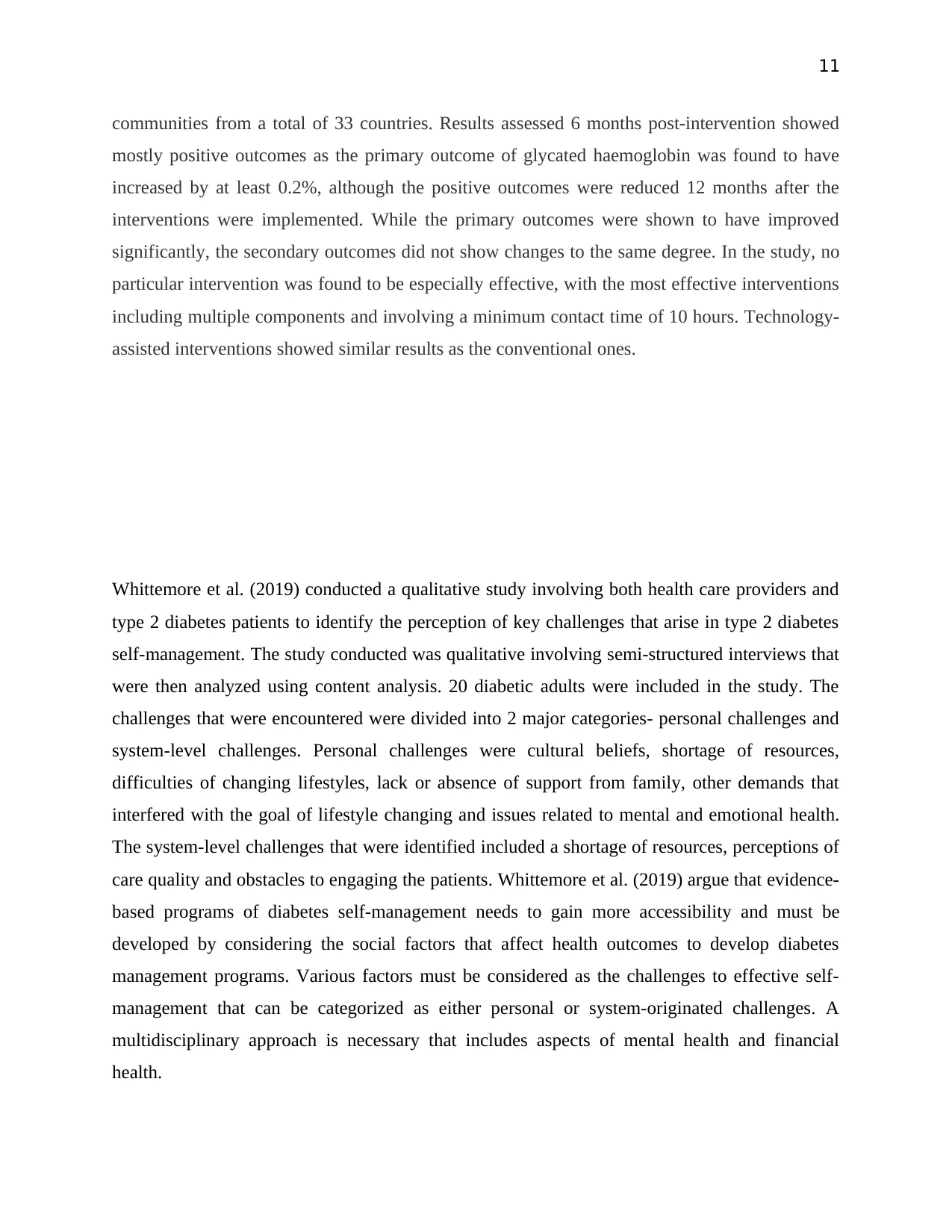
11
communities from a total of 33 countries. Results assessed 6 months post-intervention showed
mostly positive outcomes as the primary outcome of glycated haemoglobin was found to have
increased by at least 0.2%, although the positive outcomes were reduced 12 months after the
interventions were implemented. While the primary outcomes were shown to have improved
significantly, the secondary outcomes did not show changes to the same degree. In the study, no
particular intervention was found to be especially effective, with the most effective interventions
including multiple components and involving a minimum contact time of 10 hours. Technology-
assisted interventions showed similar results as the conventional ones.
Whittemore et al. (2019) conducted a qualitative study involving both health care providers and
type 2 diabetes patients to identify the perception of key challenges that arise in type 2 diabetes
self-management. The study conducted was qualitative involving semi-structured interviews that
were then analyzed using content analysis. 20 diabetic adults were included in the study. The
challenges that were encountered were divided into 2 major categories- personal challenges and
system-level challenges. Personal challenges were cultural beliefs, shortage of resources,
difficulties of changing lifestyles, lack or absence of support from family, other demands that
interfered with the goal of lifestyle changing and issues related to mental and emotional health.
The system-level challenges that were identified included a shortage of resources, perceptions of
care quality and obstacles to engaging the patients. Whittemore et al. (2019) argue that evidence-
based programs of diabetes self-management needs to gain more accessibility and must be
developed by considering the social factors that affect health outcomes to develop diabetes
management programs. Various factors must be considered as the challenges to effective self-
management that can be categorized as either personal or system-originated challenges. A
multidisciplinary approach is necessary that includes aspects of mental health and financial
health.
communities from a total of 33 countries. Results assessed 6 months post-intervention showed
mostly positive outcomes as the primary outcome of glycated haemoglobin was found to have
increased by at least 0.2%, although the positive outcomes were reduced 12 months after the
interventions were implemented. While the primary outcomes were shown to have improved
significantly, the secondary outcomes did not show changes to the same degree. In the study, no
particular intervention was found to be especially effective, with the most effective interventions
including multiple components and involving a minimum contact time of 10 hours. Technology-
assisted interventions showed similar results as the conventional ones.
Whittemore et al. (2019) conducted a qualitative study involving both health care providers and
type 2 diabetes patients to identify the perception of key challenges that arise in type 2 diabetes
self-management. The study conducted was qualitative involving semi-structured interviews that
were then analyzed using content analysis. 20 diabetic adults were included in the study. The
challenges that were encountered were divided into 2 major categories- personal challenges and
system-level challenges. Personal challenges were cultural beliefs, shortage of resources,
difficulties of changing lifestyles, lack or absence of support from family, other demands that
interfered with the goal of lifestyle changing and issues related to mental and emotional health.
The system-level challenges that were identified included a shortage of resources, perceptions of
care quality and obstacles to engaging the patients. Whittemore et al. (2019) argue that evidence-
based programs of diabetes self-management needs to gain more accessibility and must be
developed by considering the social factors that affect health outcomes to develop diabetes
management programs. Various factors must be considered as the challenges to effective self-
management that can be categorized as either personal or system-originated challenges. A
multidisciplinary approach is necessary that includes aspects of mental health and financial
health.
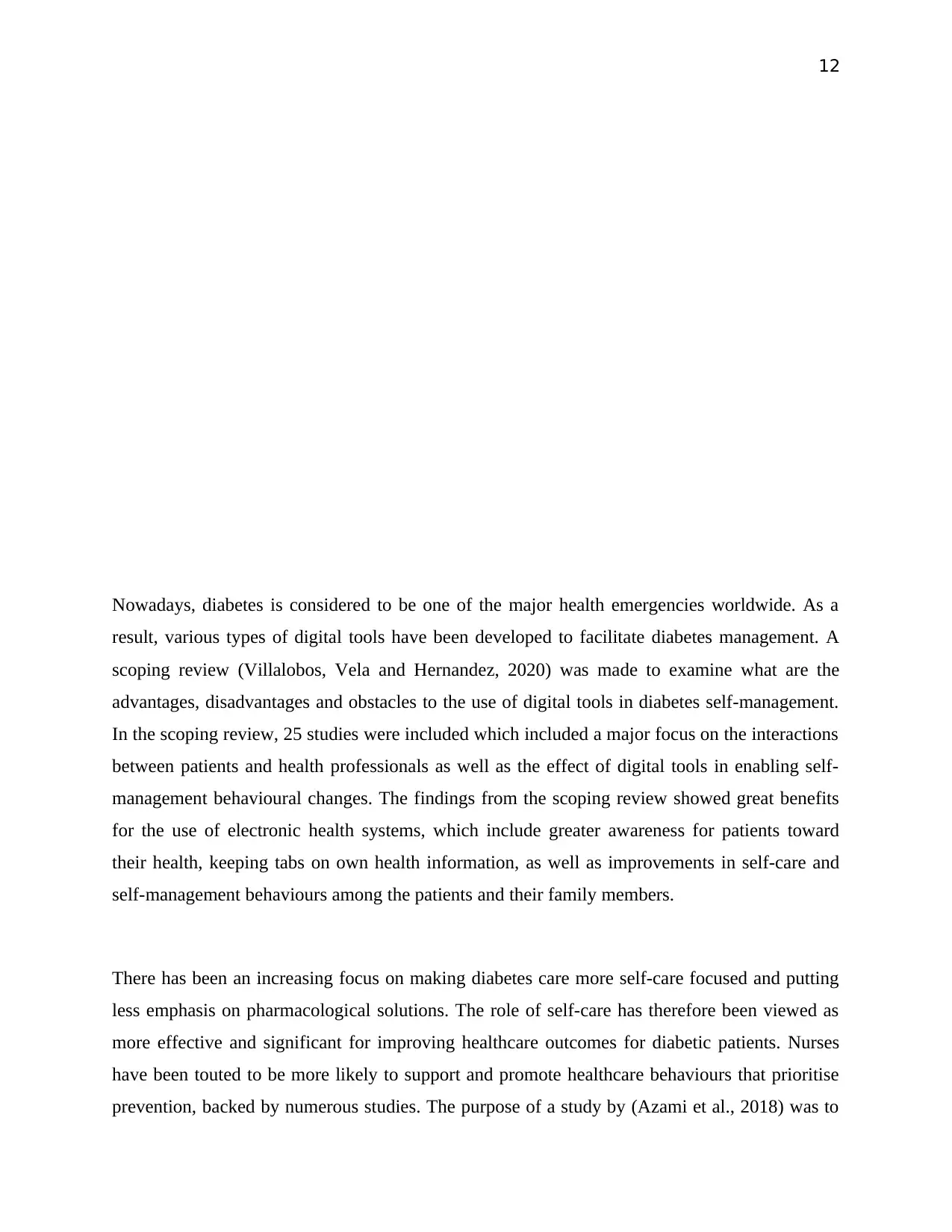
12
Nowadays, diabetes is considered to be one of the major health emergencies worldwide. As a
result, various types of digital tools have been developed to facilitate diabetes management. A
scoping review (Villalobos, Vela and Hernandez, 2020) was made to examine what are the
advantages, disadvantages and obstacles to the use of digital tools in diabetes self-management.
In the scoping review, 25 studies were included which included a major focus on the interactions
between patients and health professionals as well as the effect of digital tools in enabling self-
management behavioural changes. The findings from the scoping review showed great benefits
for the use of electronic health systems, which include greater awareness for patients toward
their health, keeping tabs on own health information, as well as improvements in self-care and
self-management behaviours among the patients and their family members.
There has been an increasing focus on making diabetes care more self-care focused and putting
less emphasis on pharmacological solutions. The role of self-care has therefore been viewed as
more effective and significant for improving healthcare outcomes for diabetic patients. Nurses
have been touted to be more likely to support and promote healthcare behaviours that prioritise
prevention, backed by numerous studies. The purpose of a study by (Azami et al., 2018) was to
Nowadays, diabetes is considered to be one of the major health emergencies worldwide. As a
result, various types of digital tools have been developed to facilitate diabetes management. A
scoping review (Villalobos, Vela and Hernandez, 2020) was made to examine what are the
advantages, disadvantages and obstacles to the use of digital tools in diabetes self-management.
In the scoping review, 25 studies were included which included a major focus on the interactions
between patients and health professionals as well as the effect of digital tools in enabling self-
management behavioural changes. The findings from the scoping review showed great benefits
for the use of electronic health systems, which include greater awareness for patients toward
their health, keeping tabs on own health information, as well as improvements in self-care and
self-management behaviours among the patients and their family members.
There has been an increasing focus on making diabetes care more self-care focused and putting
less emphasis on pharmacological solutions. The role of self-care has therefore been viewed as
more effective and significant for improving healthcare outcomes for diabetic patients. Nurses
have been touted to be more likely to support and promote healthcare behaviours that prioritise
prevention, backed by numerous studies. The purpose of a study by (Azami et al., 2018) was to
⊘ This is a preview!⊘
Do you want full access?
Subscribe today to unlock all pages.

Trusted by 1+ million students worldwide
1 out of 46
Related Documents
Your All-in-One AI-Powered Toolkit for Academic Success.
+13062052269
info@desklib.com
Available 24*7 on WhatsApp / Email
![[object Object]](/_next/static/media/star-bottom.7253800d.svg)
Unlock your academic potential
Copyright © 2020–2025 A2Z Services. All Rights Reserved. Developed and managed by ZUCOL.




